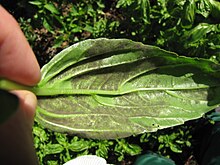| Peronospora belbahrii | |
|---|---|

| |
| Basil plant in Hawaii infected with Peronospora belbahrii | |
|
Scientific classification
| |
| Domain: | Eukaryota |
| Clade: | Diaphoretickes |
| Clade: | SAR |
| Clade: | Stramenopiles |
| Phylum: | Oomycota |
| Order: | Peronosporales |
| Family: | Peronosporaceae |
| Genus: | Peronospora |
| Species: | P. belbahrii
|
| Binomial name | |
| Peronospora belbahrii Thines
| |
Peronospora belbahrii, common name basil downy mildew, is a pathogenic water mold that affects basil species. Rapidly spread by windborn spores, the pathogen was first discovered in Italy in 2003. [1] In 2007 it was detected in Florida and by 2008 had already spread to outdoor and greenhouse basil crops in the United States and Canada. [2] Infections are untreatable and usually lead to complete crop loss, although multiple mildew-resistant cultivars have been developed and are now available for commercial and home growers. [3] Leaves from affected plants are unmarketable due to their unappetizing appearance, but remain safe for human consumption. [4]
References
- ^ Garibaldi, A.; Minuto, A.; Minuto, G.; Gullino, M. L. (2004). "First Report of Downy Mildew on Basil (Ocimum basilicum) in Italy". Plant Disease. 88 (3): 312. doi: 10.1094/PDIS.2004.88.3.312A. PMID 30812374. Retrieved 29 September 2023.
- ^ "Cornell Vegetables". Retrieved 29 September 2023.
- ^ "Maryland Grows Blog". 21 February 2020. Retrieved 29 September 2023.
- ^ "Downy Mildew on Basil in the Home Garden". University of Maryland Extension. Retrieved 29 September 2023.
| Peronospora belbahrii | |
|---|---|

| |
| Basil plant in Hawaii infected with Peronospora belbahrii | |
|
Scientific classification
| |
| Domain: | Eukaryota |
| Clade: | Diaphoretickes |
| Clade: | SAR |
| Clade: | Stramenopiles |
| Phylum: | Oomycota |
| Order: | Peronosporales |
| Family: | Peronosporaceae |
| Genus: | Peronospora |
| Species: | P. belbahrii
|
| Binomial name | |
| Peronospora belbahrii Thines
| |
Peronospora belbahrii, common name basil downy mildew, is a pathogenic water mold that affects basil species. Rapidly spread by windborn spores, the pathogen was first discovered in Italy in 2003. [1] In 2007 it was detected in Florida and by 2008 had already spread to outdoor and greenhouse basil crops in the United States and Canada. [2] Infections are untreatable and usually lead to complete crop loss, although multiple mildew-resistant cultivars have been developed and are now available for commercial and home growers. [3] Leaves from affected plants are unmarketable due to their unappetizing appearance, but remain safe for human consumption. [4]
References
- ^ Garibaldi, A.; Minuto, A.; Minuto, G.; Gullino, M. L. (2004). "First Report of Downy Mildew on Basil (Ocimum basilicum) in Italy". Plant Disease. 88 (3): 312. doi: 10.1094/PDIS.2004.88.3.312A. PMID 30812374. Retrieved 29 September 2023.
- ^ "Cornell Vegetables". Retrieved 29 September 2023.
- ^ "Maryland Grows Blog". 21 February 2020. Retrieved 29 September 2023.
- ^ "Downy Mildew on Basil in the Home Garden". University of Maryland Extension. Retrieved 29 September 2023.